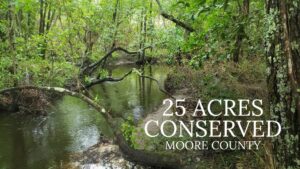
You have a family farm that’s been in your family for many generations. You’d like to see it remain as a farm forever, but your heirs may not be interested in continuing the farming tradition. What can you do?
This is one of many instances where a conservation easement might be the right tool to accomplish your goals. Conservation easements are one of the most important tools for conserving private land. Landowners continue to enjoy ownership of their land while preserving its beauty and natural characteristics for future generations. Conservation easements are negotiable documents that match owners’ property-use needs with long term benefits to their community.
What is a conservation easement? A conservation easement is a voluntary agreement that allows you to limit the type or amount of development on your property while retaining private ownership of the land. The easement extinguishes development rights and authorizes a conservation group, such as Three Rivers Land Trust, to enforce the terms. The easement ensures the property will be conserved from unwanted development, regardless of who owns the land in the future. The easement is customized for the natural resources of the property and the needs of the owner.
What land is eligible for placing into a conservation easement? Land eligible for a conservation easement must demonstrate significant conservation values. Woodlands, wetlands, farmland, endangered species habitat, scenic areas, wild and scenic rivers and historic areas are common examples.
How long do conservation easements last? Conservation easements are perpetual. They apply to the existing owners and all subsequent owners thereafter. The easement “carries with the land.” The land can be sold, leased, left to heirs, or transferred but the easement will always remain.
What are the benefits of placing a conservation easement on your property? The benefits of placing a conservation easement on your property include potential lower property tax rates on the land, reduced estate and inheritance taxes, and reduced federal income taxes for a period of time. Occasionally grant funding can be available to purchase all or a portion of a conservation easement from a landowner.
How do the tax incentives work? When you donate a conservation easement on a property, you reduce the value of the property because it can no longer be developed or subdivided. The landowner gets a conservation easement appraisal as a first step. This appraisal shows the value of the property before the easement is placed on it, and the value after it is placed on it, and the difference is the value of the conservation easement.
What are the income tax benefits? In terms of federal income tax deductions, landowners can claim a deduction of up to 50 percent of their adjusted gross income in any year. Qualifying farmers and ranchers can deduct up to 100 percent of their adjusted gross income in any year. Landowners can take those deductions the year of the gift and carry them forward for up to 15 years (or until the value of the deduction is exhausted). As always, TRLT staff are not licensed accountants, so please consult your own financial advisors to see how conservation easement donations can benefit your particular situation.
The conservation easement donation must meet the requirements of Section 170(h) of the IRS tax code, and every deduction must be based on a thorough, honest, realistic and independent appraisal prepared by a qualified and licensed appraiser. The appraiser, landowner and land trust accepting the easement all sign IRS form 8283.
So what can be done with a property after a conservation easement is placed on it? The easement generally allows for additions and modifications to existing structures, construction of accessory and farm structures, and normal agricultural practices. Most donated easements permit timbering in accordance with accepted forestry practices. Reservation of a limited number of potential future home sites also may be possible, depending on the circumstances. Some grant funded purchased conservation easements may be more restrictive and protect the land in more of a “forever wild” state, conserving natural communities from timbering.
Do conservation easements open my land up to the public? A conservation easement does not grant the public access to your land. The land trust that accepts the conservation easement will be provided access one time annually to inspect the property and ensure that the conservation values are being protected. They will contact you ahead of time and schedule the visit at a time that is convenient for you. You do not have to be present but are welcome to join the land trust staff member on the monitoring visit.
Conservation easements are completely voluntary and appropriate for landowners who wish to permanently protect and conserve the land they love. Conservation easements are as unique as the land they protect. The easement can be crafted to meet the specific needs of the owner.
A conservation easement creates a permanent legacy. It is a wonderful way to honor the memory of a family member who instilled a love and respect for land to subsequent generations.